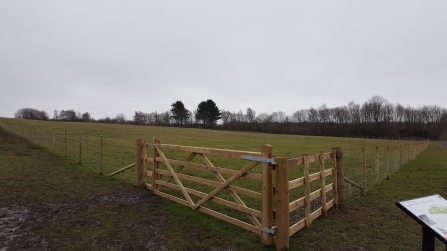
Newly constructed skylark paddock at Weetslade Country Park. Image by: Geoff Dobbins.

Newly constructed skylark paddock at Weetslade Country Park. Image by: Geoff Dobbins.
A team of Trust staff and volunteers spent December and the start of January removing tree guards from the established trees to help them flourish, fencing off the picnic area adjacent to the car park making it safe for children, and carrying out essential clearing of the thick gorse around the side of the paths to improve public access.
As the park is popular with many birds, including skylark, a three hectare enclosed skylark breeding paddock, closed to members of the public, has been created. Local landscape contractors W L Straughan & Son Ltd installed a new path between the two new paddocks and improved the drainage on the site to prevent flooding.
Each year, a team of volunteers together with the Weetslade Wardens work tirelessly to keep the park looking pristine for its thousands of visitors.
Speaking about the work, Peter Ernst, Northumberland Wildlife Trust Estates Officer said: “Each year Weetslade attracts thousands of visitors - from individuals to school groups, and our aim is to ensure the park is enjoyed by everybody so the support from volunteers in helping me keeping it looking its best is invaluable.”
Situated just to the north of Gosforth Park, Weetslade Country Park was developed on the former pit heap of Weetslade Colliery.
The shallow sloping sides of the hill contain areas of grassland, scrub and woodland. At the foot of the slopes to the west side of the site there are three developing reed beds, home to many common damselflies and dragonflies. Many birds are present on the site such as grey partridge, meadow pipit and skylark.
At this time of year, the prominence of the site makes it an ideal stopping off points for birds from Scandinavia and at the end of August, it is a haven for flocks of goldfinches.
The highest point on the site is 95m above sea level; prominent on the hilltop is the drill head sculpture, a nod to the site’s mining past.
Views to the North Sea and the Cheviot Hills are possible on a clear day with Newcastle spread out to the South.